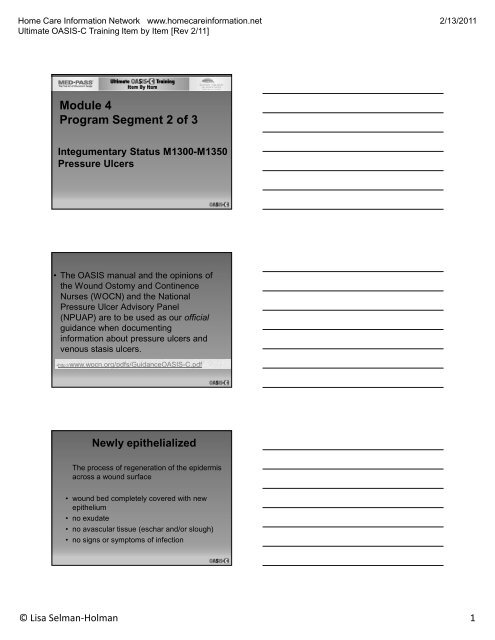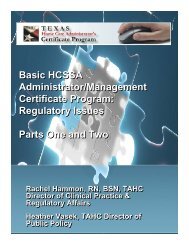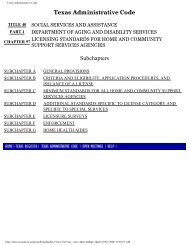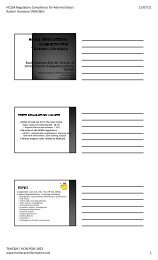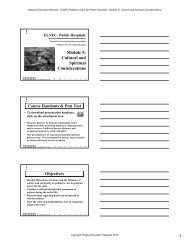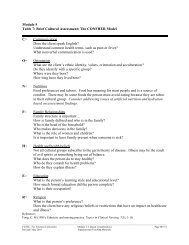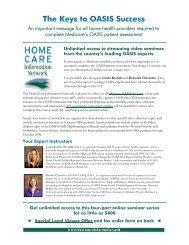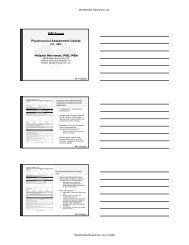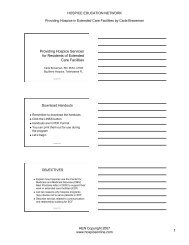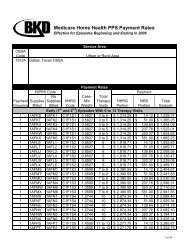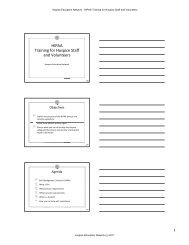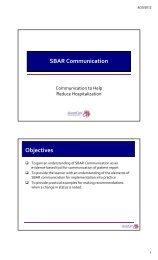Module 4 Program Segment 2 of 3 - Home Care Information Network
Module 4 Program Segment 2 of 3 - Home Care Information Network
Module 4 Program Segment 2 of 3 - Home Care Information Network
You also want an ePaper? Increase the reach of your titles
YUMPU automatically turns print PDFs into web optimized ePapers that Google loves.
<strong>Home</strong> <strong>Care</strong> <strong>Information</strong> <strong>Network</strong> www.homecareinformation.netUltimate OASIS-C Training Item by Item [Rev 2/11]2/13/2011<strong>Module</strong> 4<strong>Program</strong> <strong>Segment</strong> 2 <strong>of</strong> 3Integumentary Status M1300-M1350Pressure Ulcers• The OASIS manual and the opinions <strong>of</strong>the Wound Ostomy and ContinenceNurses (WOCN) and the NationalPressure Ulcer Advisory Panel(NPUAP) are to be used as our <strong>of</strong>ficialguidance when documentinginformation about pressure ulcers andvenous stasis ulcers.•http://www.wocn.org/pdfs/GuidanceOASIS-C.pdfNewly epithelializedThe process <strong>of</strong> regeneration <strong>of</strong> the epidermisacross a wound surface• wound bed completely covered with newepithelium• no exudate• no avascular tissue (eschar and/or slough)• no signs or symptoms <strong>of</strong> infection© Lisa Selman-Holman 1
<strong>Home</strong> <strong>Care</strong> <strong>Information</strong> <strong>Network</strong> www.homecareinformation.netUltimate OASIS-C Training Item by Item [Rev 2/11]2/13/2011Stage III Pressure UlcerFull thickness tissueloss. Sub-q fat may bevisible but bone,tendon, or muscles arenot exposed. Sloughmay be present butdoes not obscure thedepth <strong>of</strong> tissue loss.May includeundermining andtunneling.Stage III Pressure Ulcer• The bridge <strong>of</strong> the nose,ear, occiput, andmalleolus do not havesubcutaneous tissue;Stage III ulcers in theselocations can be shallow.In contrast, areas <strong>of</strong>significant adiposity candevelop extremely deepStage III pressure ulcers.Bone/tendon is not visibleor directly palpable.Stage IV Pressure Ulcer• Full thickness tissueloss with visiblebone, tendon, ormuscle. Slough oreschar may bepresent on someparts <strong>of</strong> the woundbed. Often includesundermining andtunneling© Lisa Selman-Holman 5
<strong>Home</strong> <strong>Care</strong> <strong>Information</strong> <strong>Network</strong> www.homecareinformation.netUltimate OASIS-C Training Item by Item [Rev 2/11]2/13/2011Stage IV Pressure Ulcer• The bridge <strong>of</strong> the nose, ear,occiput, and malleolus donot have subcutaneoustissue; Stage IV ulcers inthese locations can beshallow. Stage IV ulcers canextend into muscle and/orsupporting structures (eg,fascia, tendon, or jointcapsule); osteomyelitis ispossible. Exposedbone/tendon is visible ordirectly palpable.Unstageable• Known or likely but not stageable due tonon-removable dressing or device• Known or likely but not stageable due tocoverage <strong>of</strong> wound bed by slough and/oreschar.• Suspected deep tissue injury in evolution.Unstageable #d2• Full-thickness tissue loss in which the base <strong>of</strong>the ulcer is covered by slough (yellow, tan,gray, green or brown) and/or eschar (tan,brown or black) in the wound bed may rendera wound unstageable.• Further description. Until enough sloughand/or eschar is removed to expose the base<strong>of</strong> the wound, the true depth (and therefore,the stage) cannot be determined. Stable (dry,adherent, intact without erythema orfluctuance) eschar on the heels serves as“the body’s natural (biological) cover” andshould not be removed.© Lisa Selman-Holman 6
<strong>Home</strong> <strong>Care</strong> <strong>Information</strong> <strong>Network</strong> www.homecareinformation.netUltimate OASIS-C Training Item by Item [Rev 2/11]2/13/2011Unstageable #d2Suspected Deep TissueInjury• Suspected deep tissue injury in evolution, which isdefined by the NPUAP as a purple or maroon localizedarea <strong>of</strong> discolored intact skin or blood-filled blister due todamage <strong>of</strong> underlying s<strong>of</strong>t tissue from pressure and/orshear. The area may be preceded by tissue that ispainful, firm, mushy, boggy, warmer, or cooler ascompared to adjacent tissue. Deep tissue injury may bedifficult to detect in individuals with dark skin tones.Evolution may include a thin blister over a dark woundbed. The wound may further evolve and becomecovered by thin eschar. Evolution may be rapid exposingadditional layers <strong>of</strong> tissue even with optimal treatment.Suspected DTI© Lisa Selman-Holman 7
<strong>Home</strong> <strong>Care</strong> <strong>Information</strong> <strong>Network</strong> www.homecareinformation.netUltimate OASIS-C Training Item by Item [Rev 2/11]2/13/2011Healing Defined: Stage I andStage II Pressure Ulcers• Stage I and Stage II (partial thickness)pressure ulcers can heal through theprocess <strong>of</strong> regeneration <strong>of</strong> the epidermisacross a wound surface, known as“epithelialization.”NPUAP 2004• Once healed, a Stage I or II is no longerpresent.Healing Defined: Stage IIIand Stage IV Pressure Ulcers• Stage III and IV (full thickness) pressureulcers heal through a process <strong>of</strong> contraction,granulation, and epithelialization.• They can never be considered "fully healed"but they can be considered ‘closed’ whenthey are fully granulated and the woundsurface is covered with new epithelial tissue.• Once ‘closed,’ a Stage III or IV is stillpresent.Pressure UlcerGeneral Guidance• Do not reverse stage• A muscle flap, *skin advancement flap, orrotational flap performed to surgicallyreplace a pressure ulcer is a surgical woundand is no longer a pressure ulcer.• A pressure ulcer that has been surgicallydebrided remains a pressure ulcer. It doesnot become a surgical wound.*New guidance© Lisa Selman-Holman 8
<strong>Home</strong> <strong>Care</strong> <strong>Information</strong> <strong>Network</strong> www.homecareinformation.netUltimate OASIS-C Training Item by Item [Rev 2/11]2/13/2011Pressure UlcerGeneral Guidance• Unhealed: The absence <strong>of</strong> the skin’soriginal integrity. (includes closed Stage IIIand Stage IV)• Non-epithelialized: The absence <strong>of</strong>regenerated epidermis across a woundsurface.Unresolved Issue on PressureUlcers with Skin Grafts• Pressure ulcer with a skin graft is apressure ulcer.• Skin graft does not meet the definition <strong>of</strong>unstageable.• Also cannot visualize the wound bed to beable to stage.• So what to do with a pressure ulcercovered with a skin graft??M1300 Pressure Ulcer AssessmentM1302 Risk <strong>of</strong> Developing PressureUlcersProcess Measure© Lisa Selman-Holman 9
<strong>Home</strong> <strong>Care</strong> <strong>Information</strong> <strong>Network</strong> www.homecareinformation.netUltimate OASIS-C Training Item by Item [Rev 2/11]2/13/2011M1300 Pressure UlcerAssessment• Timepoints SOC ROC• Identifies patient’s risk <strong>of</strong> developing pressureulcers• CMS does not require the use <strong>of</strong> standardizedtools, nor does it endorse one particular tool.• This item is used to calculate processmeasures to capture the agency’s use <strong>of</strong> bestpractices• The best practices stated in the item are notnecessarily required in the CoPsAssessment—Pressure UlcerRiskMeasure TitlePressure UlcerRisk AssessmentConductedMeasureDescriptionPercentage <strong>of</strong> hhepisodes <strong>of</strong> careduring whichpatients wereassessed for risk<strong>of</strong> developingpressure ulcersat SOC/ROCOASIS C ItemsusedSOC/ROC:M1300 PressureUlcerAssessmentM1300 Pressure UlcerAssessment• If Response to M1300 was “0” (No pressureulcer risk assessment) note skip pattern• Use <strong>of</strong> validated standardized screening tool• Use the scoring parameters to identify if a patientis at risk for developing pressure ulcers• If tool does not define levels <strong>of</strong> risk or if evalwas based on clinical factors (w/o a validatedstandardized screening tool), then the careprovider may define what constitutes risk© Lisa Selman-Holman 10
<strong>Home</strong> <strong>Care</strong> <strong>Information</strong> <strong>Network</strong> www.homecareinformation.netUltimate OASIS-C Training Item by Item [Rev 2/11]2/13/2011M1300 Pressure UlcerAssessment• Response 1--Patient's risk for pressure ulcerdevelopment was clinically assessed, but n<strong>of</strong>ormal pressure ulcer screening tool was used.• Response 2--Formal standardized tool wasused.• Standardized tool: 1) has been scientifically testedand evaluated with a population with characteristicssimilar to the patient who is being evaluated andshown to be effective in identifying people at risk fordeveloping pressure ulcers; and 2) includes astandard response scale.• The standardized tool must be appropriatelyadministered as indicated in the instructions.M1302 Risk <strong>of</strong> DevelopingPressure Ulcers• Timepoints SOC ROC• M1302 should be skipped if response 0 wasselected for M1300 (no pressure ulcer riskassessment).• Clinicians will need to be familiar with theirAgency’s standardized screening tool• If risk is not defined by tool or if the evaluationwas based on clinical factors (without avalidated standardized screening tool), thenthe agency or care provider will need to definewhat constitutes risk.M1306 Unhealed PressureUlcer at Stage II or Higher© Lisa Selman-Holman 11
<strong>Home</strong> <strong>Care</strong> <strong>Information</strong> <strong>Network</strong> www.homecareinformation.netUltimate OASIS-C Training Item by Item [Rev 2/11]2/13/2011M1306 Unhealed PressureUlcer at Stage II or Higher• Timepoints SOC/ROC/FU/DC• Select Response 1 – Yes, if the patient hasan unhealed Stage II, OR a Stage III, orStage IV pressure ulcer at any healing statuslevel OR if the patient has an unstageableulcer(s)M1306 Unhealed PressureUlcer at Stage II or Higher• Response 0 ‘No’• The only pressure ulcer(s) is Stage 1OR if a former Stage 2 pressure ulcerhas healed AND the patient has noother pressure ulcersM1307 The Oldest Non-epithelializedStage II Pressure Ulcer© Lisa Selman-Holman 12
<strong>Home</strong> <strong>Care</strong> <strong>Information</strong> <strong>Network</strong> www.homecareinformation.netUltimate OASIS-C Training Item by Item [Rev 2/11]2/13/2011M1307 The Oldest Non-epithelializedStage II Pressure Ulcer that is presentat discharge• Timepoints Discharge• Intent <strong>of</strong> this item• Assess the length <strong>of</strong> time the Stage II ulcerremained unhealed while the patient receivedcare from the home health agency• Stage 2 pressure ulcers generally heal within 30 days• Identify patients who develop Stage II pressureulcers while under the care <strong>of</strong> the agency.M1307 The Oldest Non-epithelialized Stage IIPressure Ulcer that is present at discharge• Item refers ONLY to non-epithelialized StageII pressure ulcers that are present atdischarge. Do Not consider Stage III or IVulcers when answering this item• NPUAP states Stage II (partial thickness)pressure ulcers can heal throughepithelialization. Once epithelialized, it’sgone!• Do not reverse stage!M1307 The Oldest Non-epithelializedStage II Pressure Ulcer that ispresent at discharge• Response 2• The oldest Stage II pressure ulcer that is notfully epithelialized was first identified since themost recent SOC/ROC visit (i.e., since the lasttime the patient was admitted to home care orhad a resumption <strong>of</strong> care after an inpatient stay)• Specify the date <strong>of</strong> onset. Use two digits to indicatethe month© Lisa Selman-Holman 13
<strong>Home</strong> <strong>Care</strong> <strong>Information</strong> <strong>Network</strong> www.homecareinformation.netUltimate OASIS-C Training Item by Item [Rev 2/11]2/13/2011What’s considered forM1307?• All Stage II ulcers that are NOT healed• No stage I, III, IV or unstageable• An ulcer that is suspected <strong>of</strong> being a Stage II, butis unstageable, should not be identified as the“oldest Stage II pressure ulcer.” For this item,“unstageable” refers to pressure ulcers that areknown to be present or that the care providersuspects may be present based on clinicalassessment findings (e.g., patient report <strong>of</strong>discomfort, past history <strong>of</strong> skin breakdown in thesame area), but that are unobservable due todressings or devices (e.g., casts) that cannot beremoved to assess the skin underneath.M1308 Current Number <strong>of</strong> Unhealed (nonepithelialized)Pressure Ulcers at Each StageM1308 Current Number <strong>of</strong> Unhealed(non-epithelialized) Pressure Ulcers atEach Stage• Clinician should make every effort todetermine the wound’s most severe stage• Contact previous providers• Contact physician• An ulcer's stage can worsen, and this itemshould be answered appropriately if thisoccurs.© Lisa Selman-Holman 14
<strong>Home</strong> <strong>Care</strong> <strong>Information</strong> <strong>Network</strong> www.homecareinformation.netUltimate OASIS-C Training Item by Item [Rev 2/11]2/13/2011M1308 Current Number <strong>of</strong> Unhealed(non-epithelialized) Pressure Ulcersat Each Stage• Although the wording in M1308 includesthe term ‘non epithelialized,’ for this item,a closed Stage III or Stage IV pressureulcer should be reported as a pressureulcer at its worst stage, even if it has reepithelialized.• An epithelialized stage II is not reported.Why?Exercise: Patient has no Stage II onadmission but has a Stage II at FU.AL 0LZEROESExercise: Patient has no Stage II onadmission but has a Stage II at FU.1 0ZEROES000000© Lisa Selman-Holman 15
<strong>Home</strong> <strong>Care</strong> <strong>Information</strong> <strong>Network</strong> www.homecareinformation.netUltimate OASIS-C Training Item by Item [Rev 2/11]2/13/2011M1308 Current Number <strong>of</strong> Unhealed(non-epithelialized) Pressure Ulcers atEach StagePatient has no Stage II pressure ulcers on admission,but develops one during the first episode that ispresent at the time <strong>of</strong> follow-up.In this case, row a, column 1 would be “0” at SOC.At follow-up, row a, column 1 would be “1” and row acolumn 2 would be “0,” indicating the pressureulcer was not present on admission.Exercise: Patient has a Stage III onadmission that is a Stage IV at FU010000Exercise: Patient has a Stage III onadmission that is a Stage IV at FU000 01 1000000© Lisa Selman-Holman 16
<strong>Home</strong> <strong>Care</strong> <strong>Information</strong> <strong>Network</strong> www.homecareinformation.netUltimate OASIS-C Training Item by Item [Rev 2/11]2/13/2011M1308 Current Number <strong>of</strong> Unhealed (nonepithelialized)Pressure Ulcers at Each StageExample 2: Patient has a Stage III pressure ulceron admission that is assessed to be a Stage IV atfollow-up.In this case, row b, column 1 would be “1” at SOC.At follow-up, row b, columns 1 and 2 would both be“0,” as the patient no longer has a Stage III ulcer.Row c, column 1 would be “1” and column 2 wouldbe “1” indicating the ulcer was present onadmission, even though it was at a differentstage.Exercise: Stage II on admission thatheals within the first 2 weeks, but thendevelops another stage II prior to DC atweek 4.1ALLZEROESExercise: Stage II on admission thatheals within the first 2 weeks, but thendevelops another stage II prior to DC atweek 4.1 000000ALLZEROES© Lisa Selman-Holman 17
<strong>Home</strong> <strong>Care</strong> <strong>Information</strong> <strong>Network</strong> www.homecareinformation.netUltimate OASIS-C Training Item by Item [Rev 2/11]2/13/2011M1308 Current Number <strong>of</strong> Unhealed (nonepithelialized)Pressure Ulcers at Each Stage• Example 3: Patient has a Stage II pressure ulcer onadmission that heals within the first 2 weeks, but thendevelops another Stage II pressure ulcer prior todischarge at week 4.• In this case, row a, column 1 would be “1” at SOC. AtFollow-up, row a, column 1 would be “1” and row a,column 2 would be “0”, indicating the pressure ulcerthat is present at follow up or discharge was notpresent on admission.• For both Columns 1 and 2:• Mark a response for each row <strong>of</strong> this item: a, b, c, d1, d2, andd3. If there are NO ulcers at a given stage, enter “0” for thatstage.M1308 ROC & RecertMrs. I. M. Onabiggawound was released fromthe hospital on day 57 <strong>of</strong> the episode. Youwill be completing the ROC assessment andyou know that it will also serve as theRecertification assessment.She has a stage III pressure ulcer.Will you complete column 2 (Current Number<strong>of</strong> Unhealed Pressure Ulcers at Each Stage)on M1308 or will you leave column 2 blank?‣ CMS Q&A July 2010How to Complete M1308 onthe ROC/Recert01ZEROESLEAVEBLANK© Lisa Selman-Holman 18
<strong>Home</strong> <strong>Care</strong> <strong>Information</strong> <strong>Network</strong> www.homecareinformation.netUltimate OASIS-C Training Item by Item [Rev 2/11]2/13/2011Deep Tissue Injury NowResolvedWhen you admitted Mr. Jones you reported adeep tissue injury (DTI) in M1308 (CurrentNumber <strong>of</strong> Unhealed Pressure Ulcers atEach Stage)You are now discharging Mr. Smith and thereare no signs or symptoms <strong>of</strong> DTI. How shouldyou answer M1308, Row d3, column 2?‣ CMS Q&A July 2010Deep Tissue Injury Now ResolvedALLZEROESALLZEROESAt Discharge, if the patient has no pressure ulcers and thesuspected DTI had not evolved and is now resolved, enter “0”in all rows and columns in M1308.M1310, M1312, M1314 LargestSurface Dimension© Lisa Selman-Holman 19
<strong>Home</strong> <strong>Care</strong> <strong>Information</strong> <strong>Network</strong> www.homecareinformation.netUltimate OASIS-C Training Item by Item [Rev 2/11]2/13/2011Length M1310, Width M1312,and Depth M1314• Timepoints SOC ROC Discharge• Complete these items only if M1308Column 1, rows b, c, or d.2 is greater than0. Otherwise, leave these items blank.(Stage III, IV or unstageable due to escharor slough)• Ignore non-epithelialized• Surface area = length x width• Record in centimeters (to the nearest 10 th <strong>of</strong> acentimeter)Length M1310, Width M1312,and Depth M1314• Acceptable means <strong>of</strong> wound measurement• Disposable measuring device e.g. cottontippedapplicator• Camera• Other wound technology that calculatesmeasurements• Note: If you can visualize it, measure it!!Even if all you see is a wound bed that is100% covered with slough/eschar.Length M1310, WidthM1312, and Depth M1314• If all existing Stage III or IV pressure ulcers areclosed (completely re-epithelialized) and the patienthas no pressure ulcers that are unstageable due tocoverage <strong>of</strong> the wound bed by slough and/oreschar, enter 00.0 for M1310, M1312, and M1314• Non-epithelialized unstageable (due to thepresence <strong>of</strong> slough or eschar as reported in M1308d.2) Stage III or IV must be measured• Determine which has largest surface dimension(L x W)• Do not consider depth (00.0)© Lisa Selman-Holman 20
<strong>Home</strong> <strong>Care</strong> <strong>Information</strong> <strong>Network</strong> www.homecareinformation.netUltimate OASIS-C Training Item by Item [Rev 2/11]2/13/2011When measuring a P/U depth—does depth include the depth <strong>of</strong> atunnel?• When measuring the depth <strong>of</strong> a pressure ulcer—report the depth from the visible surface to thedeepest area in the base <strong>of</strong> the wound, which doesnot include the depth <strong>of</strong> any tunneling present.• Best Practices, as recommended by the WOCNpressure ulcer Guidelines would encouragedocumentation within the comprehensive assessment<strong>of</strong> additional details regarding the wound that are notreported in specific OASIS items, including presence,location and depth <strong>of</strong> sinus tracts or underminedareas. CMS Q&A July 2010© Lisa Selman-Holman 21
<strong>Home</strong> <strong>Care</strong> <strong>Information</strong> <strong>Network</strong> www.homecareinformation.netUltimate OASIS-C Training Item by Item [Rev 2/11]2/13/2011M1320 Status <strong>of</strong> Most Problematic(Observable) Pressure UlcerNewly epithelializedThe process <strong>of</strong> regeneration <strong>of</strong> theepidermis across a wound surface• wound bed completely covered with newepithelium• no exudate• no avascular tissue (eschar and/orslough)• no signs or symptoms <strong>of</strong> infectionFully Granulating• wound bed filled with granulation tissue tothe level <strong>of</strong> the surrounding skin• no dead space• no avascular tissue (eschar and/or slough)• no signs or symptoms <strong>of</strong> infection• wound edges are open© Lisa Selman-Holman 22
<strong>Home</strong> <strong>Care</strong> <strong>Information</strong> <strong>Network</strong> www.homecareinformation.netUltimate OASIS-C Training Item by Item [Rev 2/11]2/13/2011Early/Partial Granulation• ≥ 25% <strong>of</strong> the wound bed is covered withgranulation tissue• < 25% <strong>of</strong> the wound bed is covered withavascular tissue (eschar and/or slough)• no signs or symptoms <strong>of</strong> infection• wound edges openNot Healing• ≥ 25% avascular tissue OR• S/S <strong>of</strong> infection OR• Clean but non granulating wound bed OR• Closed/hyperkeratotic wound edges OR• Persistent failure to improve despiteappropriate comprehensive woundmanagementM1320 Status <strong>of</strong> Most Problematic(Observable) Pressure Ulcer:• Timepoints SOC/ROC/DC• Identifies the degree <strong>of</strong> closure visible in themost problematic observable pressureulcer, stage II or higher. (Stage Is are notconsidered.)• Visualization <strong>of</strong> the wound is necessary toidentify the degree <strong>of</strong> healing evident in theulcer identified in M1320.© Lisa Selman-Holman 23
<strong>Home</strong> <strong>Care</strong> <strong>Information</strong> <strong>Network</strong> www.homecareinformation.netUltimate OASIS-C Training Item by Item [Rev 2/11]2/13/2011M1320 Status <strong>of</strong> Most Problematic(Observable) Pressure Ulcer:• Most problematic• May be the largest• The most advanced stage• The most difficult to access for treatment• The most difficult to relieve pressure, etc.,• If the patient has only one observablepressure ulcer, then that ulcer is the mostproblematic.M1320 Status <strong>of</strong> MostProblematic (Observable)Pressure Ulcer:• Mark the response that most accuratelydescribes the healing process you seeoccurring in the most problematic pressureulcer.• Stage III and IV pressure ulcers close bycontraction, granulation, andepithelialization.M1320 Status <strong>of</strong> MostProblematic (Observable)Pressure Ulcer:• Response 0 ‘Newly epithelialized’• Tissue has completely covered the woundsurface <strong>of</strong> the pressure ulcer• Regardless <strong>of</strong> how long the pressureulcer has been re-epithelialized.• This is an appropriate response for Stage IIIand IV pressure ulcers, but not for Stage IIulcers as fully epithelialized Stage II ulcersshould not be reported.© Lisa Selman-Holman 24
<strong>Home</strong> <strong>Care</strong> <strong>Information</strong> <strong>Network</strong> www.homecareinformation.netUltimate OASIS-C Training Item by Item [Rev 2/11]2/13/2011M1320 Status <strong>of</strong> MostProblematic (Observable)Pressure Ulcer:• Response 1 – Fully Granulating• Stage III or IV that epithelial tissue has notcompletely covered the wound surface• Response 3 - Not healing• Stage II• Do not granulate, therefore, must bereported as Response ‘3’ not healing• Suspected deep tissue injury that has notevolved is considered not healing.M1320 Status <strong>of</strong> MostProblematic (Observable)Pressure Ulcer:• NA- No observable pressure ulcer• Includes only those that cannot be observeddue to the presence <strong>of</strong> a dressing or device thatcannot be removed (including casts).• When determining the healing status <strong>of</strong> apressure ulcer for answering M1320, thepresence <strong>of</strong> necrotic tissue does NOT make thepressure ulcer NA – No observable pressureulcer.M1320 Status <strong>of</strong> MostProblematic (Observable)Pressure Ulcer:• A pressure ulcer with necrotic tissue(eschar/slough) obscuring the wound basecannot be staged, but its healing status iseither Response 2 – Early/partialgranulation if necrotic or avascular tissuecovers
<strong>Home</strong> <strong>Care</strong> <strong>Information</strong> <strong>Network</strong> www.homecareinformation.netUltimate OASIS-C Training Item by Item [Rev 2/11]2/13/2011M1322 Current Number <strong>of</strong>Stage I Pressure Ulcers• Timepoints SOC/ROC/FU/Discharge• NRSM1324 Stage <strong>of</strong> the MostProblematic Unhealed(observable) Pressure UlcerM1324 Stage <strong>of</strong> Most ProblematicUnhealed (Observable) Pressure Ulcer• Timepoints SOC/ROC/FU/Discharge• Must be able to visualize ulcer• Determine the most problematic pressureulcer• Identify the degree <strong>of</strong> healing evident in theulcer.• If the patient has only one observablepressure ulcer, then that ulcer is the mostproblematic.© Lisa Selman-Holman 26
<strong>Home</strong> <strong>Care</strong> <strong>Information</strong> <strong>Network</strong> www.homecareinformation.netUltimate OASIS-C Training Item by Item [Rev 2/11]2/13/2011M1324 Stage <strong>of</strong> Most ProblematicUnhealed (Observable) PressureUlcer• Most problematic may be• Largest• Most advanced stage• Most difficult to access for treatment• Most difficult to relieve pressure, etc.,depending on the specific situation.M1324 Stage <strong>of</strong> Most ProblematicUnhealed (Observable) Pressure Ulcer• Follow NPUAP to make determination--No reversestaging!!• “NA”• NO pressure ulcers• Pressure ulcers cannot be observed due to necrotictissue (including eschar or slough) that obscuresvisualization <strong>of</strong> the wound base• A pressure ulcer that is covered with eschar cannot be stageduntil the wound bed is visible (even if previously staged).• Non-removable dsg or cast• Until the SDTI evolves and opens, the Stage will beconsidered NA, as the wound bed cannot be visualizedThe Specifics on SuturedPressure UlcersQuestion 3: How do I categorize a pressure ulcerthat has been sutured closed?Answer 3: Since it is relatively uncommon toencounter direct suture closure <strong>of</strong> a pressureulcer, it is important to make sure that thepressure ulcer was not closed by a surgicalprocedure (such as a skin advancement flap,rotation flap, or muscle flap). A pressure ulcerthat is sutured closed (without a flap procedure)would still be reported as a pressure ulcer.While this approach (direct suture closure) mayrarely be attempted due to a low success rate,home care providers are reporting occurrence.© Lisa Selman-Holman 27
<strong>Home</strong> <strong>Care</strong> <strong>Information</strong> <strong>Network</strong> www.homecareinformation.netUltimate OASIS-C Training Item by Item [Rev 2/11]2/13/2011Sutured Pressure UlcerXSince the pressure ulcer issutured closed, the pressure ulceris considered unstageable.Sutured Pressure UlcerZEROSThis pressure ulcer is treated as unstageable dueto non-removable dressing or device.100Sutured Pressure UlcerLeave these blank as the pressure ulcer cannot bemeasured.© Lisa Selman-Holman 28
<strong>Home</strong> <strong>Care</strong> <strong>Information</strong> <strong>Network</strong> www.homecareinformation.netUltimate OASIS-C Training Item by Item [Rev 2/11]2/13/2011Sutured Pressure UlcerXBecause this pressure ulcer is being treated asone covered with a dressing or device, NA isthe appropriate answer.Sutured Pressure UlcerXBecause this pressure ulcer is being treated as onecovered with a dressing or device, NA is theappropriate answer.The Specifics on Pressure UlcersWith Skin GraftsMrs. Rose was admitted for aftercare postskin graft <strong>of</strong> a Stage III pressure ulcer <strong>of</strong>the hip with orders for the pressuredressing to remain in place until thepatient’s first <strong>of</strong>fice visit.What will you report at the SOC assessmentfor M1308, M1320, and M1324?CMS Q&A July2010© Lisa Selman-Holman 29
<strong>Home</strong> <strong>Care</strong> <strong>Information</strong> <strong>Network</strong> www.homecareinformation.netUltimate OASIS-C Training Item by Item [Rev 2/11]2/13/2011Pressure Ulcer/Skin Graft/Non-Removable DressingZEROES001Pressure Ulcer/Skin Graft/Non-Removable DressingXThis pressure ulcer is covered with a nonremovabledressing or device; NA is theappropriate answer.Pressure Ulcer/Skin Graft/Non-Removable DressingXThis pressure ulcer is covered with a non-removabledressing or device; NA is the appropriate answer.© Lisa Selman-Holman 30
<strong>Home</strong> <strong>Care</strong> <strong>Information</strong> <strong>Network</strong> www.homecareinformation.netUltimate OASIS-C Training Item by Item [Rev 2/11]2/13/2011Pressure Ulcers/SkinGrafts/Healed CMS Q&A July2010At Discharge, Mrs. Rose’s graft site hashealed with some contracture anddiscoloration <strong>of</strong> the grafted site, whatis the appropriate response forM1308, M1320, and M1324?Pressure Ulcers/SkinGrafts/Healed0 00100 001ZEROESPressure Ulcers/SkinGrafts/HealedXThis pressure ulcer is covered with epithelialtissue.© Lisa Selman-Holman 31
<strong>Home</strong> <strong>Care</strong> <strong>Information</strong> <strong>Network</strong> www.homecareinformation.netUltimate OASIS-C Training Item by Item [Rev 2/11]2/13/2011Pressure Ulcers/SkinGrafts/HealedXThis pressure ulcer is a closed Stage III.Pressure Ulcer/Skin Graft/NotHealed YetMr. Adams is being admitted to your agency foraftercare post skin graft <strong>of</strong> a Stage IIIpressure ulcer. The autologous graft is notedto be sutured in place and the bed <strong>of</strong> theulcer is not visible. The graft appears to behealthy, there are no signs or symptoms <strong>of</strong>infection, breakdown or rejection and withcomplete re-epithelialization at the edges.• How will you respond to M1308, M1320 andM1324 on the SOC OASIS? CMS Q&A July 2010Pressure Ulcer/Skin Graft/NotHealed Yet010000© Lisa Selman-Holman 32
<strong>Home</strong> <strong>Care</strong> <strong>Information</strong> <strong>Network</strong> www.homecareinformation.netUltimate OASIS-C Training Item by Item [Rev 2/11]2/13/2011Pressure Ulcer/Skin Graft/NotHealed YetXThis pressure ulcer’s graft edges areepithelialized.Pressure Ulcer/Skin Graft/NotHealed YetXThis pressure ulcer is still a Stage III.END<strong>Module</strong> 4<strong>Program</strong> <strong>Segment</strong> 2 <strong>of</strong> 3Please complete ALL 3 programsegments prior to starting theevaluation and post-test for thislearning module.© Lisa Selman-Holman 33


